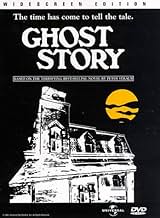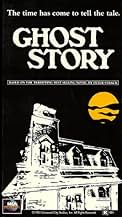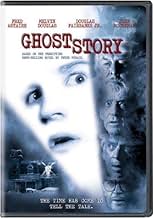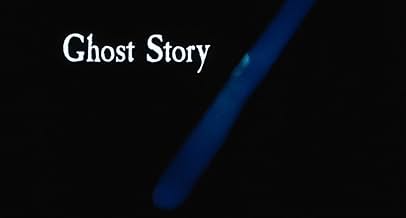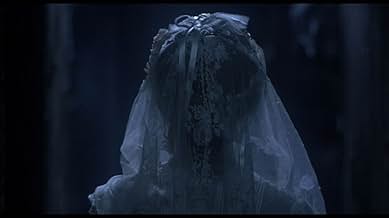NOTE IMDb
6,3/10
11 k
MA NOTE
Une série de morts mystérieuses révèle la mauvaise conscience de quatre notables d'une petite ville du Vermont. Ces derniers ont provoqué la mort d'une ravissante jeune femme qui s'est noyée... Tout lireUne série de morts mystérieuses révèle la mauvaise conscience de quatre notables d'une petite ville du Vermont. Ces derniers ont provoqué la mort d'une ravissante jeune femme qui s'est noyée quelques années auparavant.Une série de morts mystérieuses révèle la mauvaise conscience de quatre notables d'une petite ville du Vermont. Ces derniers ont provoqué la mort d'une ravissante jeune femme qui s'est noyée quelques années auparavant.
- Réalisation
- Scénario
- Casting principal
- Récompenses
- 3 nominations au total
Avis à la une
When this film was first released, it was greeted with a sense of disappointment. Many felt it did not do Peter Straub's source novel justice.
I thought this was an unfair judgement at the time, and watching the film again today confirms this belief. "Ghost Story" does not attempt to emulate the complexity of Straub's epic tale : that would have been impossible. But it does distil the essence of that story - four ageing men haunted by a terrible tragedy from their youth - and puts it on screen with chilly precision.
With some masterly photography and a recurring motif of running water (most dramatically in the truly scary bathtub scene), Irvin imbues the film with a real chill of the grave feel. The ending, as Alma descends the staircase of her decaying house in her wedding dress, isn't a gorefest : there are no elaborate effects or dramatic battles between good and evil. But it is subtly terrifying nonetheless.
Just about all the IMdB reviews, good or bad, have praised Alice Krige's performance. For such a young actress, she's simply stunning. It's a brave, brilliant portrayal. A feminist reading of the film could argue that the real horror lies in the inability of men (and especially the callow youngsters featured in the 20s flashback) to cope with a powerful, sexually-assertive woman.
This is a clever, stylish film which lends itself to differing interpretations. It creates more elegant frissons of fear than almost any other 80s horror film.
I thought this was an unfair judgement at the time, and watching the film again today confirms this belief. "Ghost Story" does not attempt to emulate the complexity of Straub's epic tale : that would have been impossible. But it does distil the essence of that story - four ageing men haunted by a terrible tragedy from their youth - and puts it on screen with chilly precision.
With some masterly photography and a recurring motif of running water (most dramatically in the truly scary bathtub scene), Irvin imbues the film with a real chill of the grave feel. The ending, as Alma descends the staircase of her decaying house in her wedding dress, isn't a gorefest : there are no elaborate effects or dramatic battles between good and evil. But it is subtly terrifying nonetheless.
Just about all the IMdB reviews, good or bad, have praised Alice Krige's performance. For such a young actress, she's simply stunning. It's a brave, brilliant portrayal. A feminist reading of the film could argue that the real horror lies in the inability of men (and especially the callow youngsters featured in the 20s flashback) to cope with a powerful, sexually-assertive woman.
This is a clever, stylish film which lends itself to differing interpretations. It creates more elegant frissons of fear than almost any other 80s horror film.
Four elderly men members of The Chowder Society fall victim to a vengeful ghost (Alice Krige) who seems to be connected to something they did decades ago and who once dated one of the member's son (Craig Wasson) from beyond the grave. Old fashioned, entertaining film features possibly the best cast ever gathered to star in a horror film. The film itself has a very atmospheric feel to it and generates some suspense, but never really scares the auidence.
Rated R; Nudity, Sexual Situations, Violence, and Profanity.
Rated R; Nudity, Sexual Situations, Violence, and Profanity.
I initially wanted to rate "Ghost Story" a fine 7/10, but I figured since I (voluntarily) had to endure watching such heavy rubbish earlier this week, I'd just chip in an extra point. I feel no shame about this, as the film is actually very good. At the start of the '80s, the horror landscape was changing. Films got a lot crazier, partly due to many great sfx artists rising to the scene and otherwise because of the mindset of that era (fashion, trends, etc). Often filmmakers cared less about telling a coherent story and more about making their films go over-the-top in any way they'd see fit. So in a way "Ghost Story" really feels like if it was one of the last 'classic' horror movies at the time. From the orchestrated soundtrack over the slow pace of the film, relying more on mood, tension and atmosphere to the splendid performances of our veteran foursome Fred Astaire, Melvin Douglas, John Houseman and Douglas Fairbanks Jr. The film is ingeniously structured, with various stories within the main story, nightmarish dream sequences and a great flashback story to the 1930's era. The settings provide some classic horror elements too, like the isolated snowy town, grisly frozen lakes and an old ramshackle haunted mansion. Sporadically, the film is also injected with some amusing scares provided by ghostly rotting appearances and the special visual effects by master matte artist Albert Whitlock are outstanding. Gorgeous actress Alice Krige has that icy cold mysteriousness over her that is fitting for her role. On top of that, she has more scenes with her clothes off then on. There are a couple subplots that could have been altered to make it an even better movie, but these are only minor problems. If you want a decent scary movie double bill with a classy feel to it for a dark & stormy night, I think teaming up John Irvin's "Ghost Story" (1981) with Peter Medak's "The Changeling" (1980) might work wonders.
Watched this one in the theater when I was a kid, still enjoy it to this day as one my all time favorite movies. Yes, it does have holes in it and sparks some questions as to why the one seeking revenge is doing what they're doing. There are solid performances from ALL the cast members, especially from Craig Wasson and Alice Krieg If you've ever read the book by Peter Struab, you'll know why there's holes in the movie as the book is very much like a 'Stephen King' book, in that it is so rich with information and atmosphere that the film producers and John Irvin just could not get all of it into a 2 hour film. I actually a couple of years ago that they might be re'making this one, but as a Mini-Series on TV
I give it 8 out of 10 stars
Enjoy
I give it 8 out of 10 stars
Enjoy
... with a fantastic cast of veterans - Fred Astaire, John Houseman, Melvyn Douglas, Douglas Fairbanks Jr, and Patricia Neal. Unfortunately, the film always keeps getting in the way, leaving the veterans with scant onscreen attention.
The tale concerns a group of men, haunted by a death they were all accidentally responsible for in the early 1930s, and what happens when the ghost of that victim (Alice Krige) returns for vengeance, resulting in a lot of men shocked to death and abrupt shock cuts that show a rotting corpse in place of Krige's face. Unfortunately, maybe because of studio interference, the majority of screentime goes to Craig Wasson as a pair of Fairbanks' identical twin sons, one ill-fated very early on, the other more successful in surviving. Frankly put, although he isn't bad in the film, it feels like false advertising. (Wasson also has to have one of the tackiest death scenes in cinema history as the ill-fated brother who, terrified by Krige's skeletal look after a night of sex, plunges backwards stark naked from a high-rise window, as the film shows him against a badly processed back projection flailing his arms about, while his private parts flutters every which way like a Planters peanut caught in a strong wind). There's a reason Krige goes after the next generation in the case of Fairbanks' sons, but you'll have to watch and find out what that reason is.
So, Astaire and all the others I came to see are left with mere onscreen scraps, and are left with unformed characterizations. That feels like a grave betrayal for this classic film fan, especially in the light that it was the final film for Astaire, Douglas, and Fairbanks.
There were some particularly well-done parts though. For one Alice Krige was perfect for her part because her porcelain doll looks make her appear to be somebody out of an earlier time. Winter in the New England town the veteran actors live in has the look of a place that's haunted - it's very atmospheric. And finally, the film points out how having a crisis at 20 rather than 30 makes all the difference in the world as to the calmness and wisdom with which that crisis is handled.
The tale concerns a group of men, haunted by a death they were all accidentally responsible for in the early 1930s, and what happens when the ghost of that victim (Alice Krige) returns for vengeance, resulting in a lot of men shocked to death and abrupt shock cuts that show a rotting corpse in place of Krige's face. Unfortunately, maybe because of studio interference, the majority of screentime goes to Craig Wasson as a pair of Fairbanks' identical twin sons, one ill-fated very early on, the other more successful in surviving. Frankly put, although he isn't bad in the film, it feels like false advertising. (Wasson also has to have one of the tackiest death scenes in cinema history as the ill-fated brother who, terrified by Krige's skeletal look after a night of sex, plunges backwards stark naked from a high-rise window, as the film shows him against a badly processed back projection flailing his arms about, while his private parts flutters every which way like a Planters peanut caught in a strong wind). There's a reason Krige goes after the next generation in the case of Fairbanks' sons, but you'll have to watch and find out what that reason is.
So, Astaire and all the others I came to see are left with mere onscreen scraps, and are left with unformed characterizations. That feels like a grave betrayal for this classic film fan, especially in the light that it was the final film for Astaire, Douglas, and Fairbanks.
There were some particularly well-done parts though. For one Alice Krige was perfect for her part because her porcelain doll looks make her appear to be somebody out of an earlier time. Winter in the New England town the veteran actors live in has the look of a place that's haunted - it's very atmospheric. And finally, the film points out how having a crisis at 20 rather than 30 makes all the difference in the world as to the calmness and wisdom with which that crisis is handled.
Le saviez-vous
- AnecdotesFinal theatrical feature film of veteran actors Melvyn Douglas, Fred Astaire, and Douglas Fairbanks Jr.
- GaffesRobert Burr is credited as " Principal ". Since the school in the film is a college, his title in the credits should be " Dean ".
- Versions alternativesThe Australian theatrical version was cut to receive a more commercial 'M' rating (all ages admitted but recommend for 15 and over) rather then an 'R' rating (restricted to 18 years and over).
- Bandes originalesSweetheart of Sigma Chi
Written by F. Dudleigh Vernor and Byron D. Stokes
Performed by Guy Lombardo and The Royal Canadians (as His Royal Canadians)
Meilleurs choix
Connectez-vous pour évaluer et suivre la liste de favoris afin de recevoir des recommandations personnalisées
Détails
Box-office
- Budget
- 13 500 000 $US (estimé)
- Montant brut aux États-Unis et au Canada
- 23 371 905 $US
- Week-end de sortie aux États-Unis et au Canada
- 2 105 729 $US
- 20 déc. 1981
- Montant brut mondial
- 23 371 905 $US
- Durée
- 1h 50min(110 min)
- Mixage
- Rapport de forme
- 1.33 : 1(original ratio, open matte)
Contribuer à cette page
Suggérer une modification ou ajouter du contenu manquant





